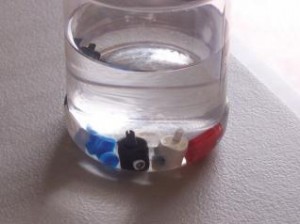
Store spray-can nozzles in a jar of thinner for a supply of clean nozzles that are ready to apply a perfect finish.
Spray-finish nozzles that refuse to spray, spray sideways, or spit and sputter cause frustration and can ruin a project.
To prevent this, I always remove the spray nozzle from the can and place it in a jar of appropriate thinner—usually lacquer thinner or paint thinner.
When you need the nozzle, take it out of the thinner and it’s perfectly clean. If you have a clogged nozzle, soak the nozzle in thinner.
You may need to use a sewing needle to pick out the softened finish. It’s not possible to save every nozzle, so when a can of finish is empty; I keep the nozzle as a backup. This works with spray-adhesive nozzles as well.
Mike Mickelson
Hamilton, Mont.
Wooden Bowls from the Scroll Saw | Making Wooden Chess Sets
Glue Squeeze-out
It can be difficult to clean up glue squeeze-out, especially where glued joints meet at grooves or angles. I push a 1/4″-diameter plastic drinking straw along the glue line to scoop up squeezed-out wet glue. When the glue is collected, it may be used in other areas or simply discarded. Just snip off the straw above the glue residue and the straw is ready for the next cleanup job.
Garry Shilliday
Via E-mail
Seashore and Nautical Patterns for the Scroll Saw | Box Making Projects for the SS
Removing Patterns
Removing patterns attached to a blank with spray adhesive can be tedious. I don’t like to use strong-smelling solvents, but a heat gun is slow and may damage the stock.
For small- and medium-sized blanks, place the wood with the pattern attached into the microwave for 25 to 30 seconds. The pattern will pull off easily without leaving a residue.
Robert O’Brien
Mascoutah, Ill.







